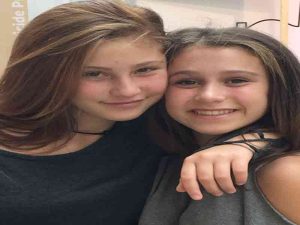When 12-year-old Courtland Millman witnessed her friend being bullied on a social media app, she felt she couldn’t just stand by.
Last summer, Courtland created the hashtag #StopTheBully in hopes of raising awareness among her peers about the effect cyber bullying can have on people.
Bullying occurs in a situation where there is a real or perceived power imbalance. It is a complex problem that can be defined by physical abuse, damaging or stealing property, teasing, name-calling, exclusion, spreading rumours, public shaming and intimidation.
Traditionally, bullying takes place on the school bus and school grounds, but today, there is the added challenge of online bullying where people can hide behind a screen and threaten, harass, embarrass, socially exclude, or damage reputations and friendships by sharing private information, photos or videos.
“There is an app called Sarahah where anybody can ask anything and you won’t know who it is,” Courtland explained.
“My friend… was getting hateful and rude comments. I texted her back to make sure she was OK, then I posted on my story how this app is ruining people’s self-esteem. I posted on my Snapchat story that you should delete this app right now. I did this for my friend, and for my sister who was also a victim of bullying. At the end of my Snapchat story, I posted, ‘If you care not only about her, but everybody else around you who is getting bullied, post on your own story #StopTheBully and see who really cares.’”
Courtland said that after that, 75 per cent of the stories that were published by her peers contained the hashtag. Courtland recalled how her 14-year-old sister Samantha Millman had been victimized.
READ: PANEL ON DEPRESSION AND SUICIDE STRIKES A CHORD
“You are so ugly. You are so fat. You are not worth it. That’s how my sister was bullied,” Courtland said.
Samantha Millman is a Grade 9 student who suffers from depression as a result of bullying that occurred when she was in Grades 3 through 5.
“I was a victim of verbal bullying – consistent daily outbursts of insults being thrown at me by the same person for two years. I remember one time we were practicing this song for an assembly and ironically enough it was an anti-bullying song. I was sitting beside him. The entire grade was in the room including our teachers. I didn’t think anything would happen,” Samantha said.
‘I am hoping that #StopTheBully promotes conversations in families and institutions and amongst kids themselves’
“But I was not safe from him. He called me stupid, my brother stupid… what you would expect from someone that age. He had no remorse.”
Educators eventually intervened and an apology was given.
“They got him to apologize. He was told to. After that, the bullying became more subtle and then suddenly stopped. I think he got bored with it,” Samantha said.
But the bullying had taken its toll and by the end of Grade 6, Samantha became depressed.
“I was thinking maybe he was right. I tried to think it was nothing, but boy, was I wrong,” Samantha said.
According to a study on bullying, a child who is bullied will often say nothing in order to protect their parents from the pain and shame they are feeling.

“It’s difficult for a young person to articulate feelings and put those feelings into perspective,” Lauren Millman, the sisters’ mother who works as a mental health practitioner, said.
“Yet, because you are so young and influenced by it, and because little brains are very malleable, we weren’t aware for a while how deep it was hurting Samantha. When we realized it was more serious than residual bullying we got her the help she needed.”
“I am hoping that #StopTheBully campaign promotes conversations in families and institutions and amongst the kids themselves. We need to empower our children,” Millman said.
Samantha’s advice to other victims of bullying: “Do what I didn’t. Get help. Your parents are a good place to go.”
